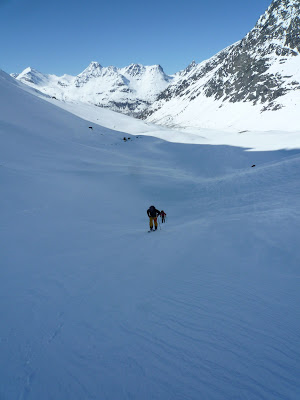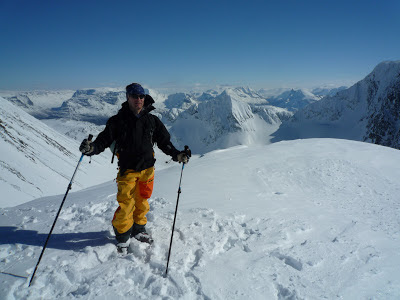
Round much of the UK, the border between land and ocean is pretty abrupt - there are a lot of cliffs where the land drops precipitately away into the sea. Indeed sea cliff climbing is a very special part of UK climbing, and something that isn't as common elsewhere as you might think. Finland is different - for a lot of the coastline the border is much more fuzzy - sea and land bleed into each other with the archipelagos of little islands, peninsular and skerries and the forest-fringed bays, channels and fjords in-between. Sea views of the type normal in the UK are oddly rare along the southern coast of Finland at least - from the mainland there are normally islands further out blocking your view to open water. Sailing is obviously a great way to explore all these channels and island and unsurprisingly popular. You might not need to think much of tides or waves or storms sailing around coastal Finland but you do need to read your charts/GPS plotter very carefully to watch out for the myriad of rocks, reefs and shallow water that abounds.
 |
| Busy shipping lanes passing the approaches to Turku |
I'm a bit of a landlubber but still love being out on the sea, so am very fortunate that my friend and regular climbing partner Dave is an experienced and keen sailor and sometime I get crew for him. This generally takes the form of him laughing at me for being so slow on the winches and conversations along the lines of:
Dave: "haul in the tiddly-pong to tauten the widdly-dee!"
Toby: "....errr?? You what?"
 |
| Sailing in the Turku archipelago |
|
But when Dave told me a couple of years ago about an interesting looking crag he had seen while sailing I was even more keen than normal to get on the boat and be completely out of my natural element. We've now been twice and it's a beautiful place with some nice little climbs, so well worth a visit for any Finnish climbers who have access to a boat.
 |
| Wine on the rocks |
 |
| Jellyfish - there were LOTS of these on the first visit |
Sea kayakers who know what they are doing could also get there reasonably easily starting from road 1830 south of Dalsbruk. There are plenty of other little islands between the mainland and Kyrkskär, so you could island hop with a maximum open water sections of only a couple of kilometres.
 |
| Dave on the first ascent of Iiris Corner (5/HVS 5a) |
The reason for the two visits was the climb that would become Iiris Corner - the most obvious and strongest line on the crag. On the first visit I hadn't brought along my biggest cam - the biggest we had was a #4 Camalot and despite it's rather big size, it still wasn't enough to protect the crux moves. On the second visit I had my big Rock Empire Pulsar (I guess about the same size as a #5 Camalot) and with some judicious shoving it up the wide bit ahead of him, Dave 'sent' the first ascent. You need the cam to protect getting on to the foot ledge at about two thirds height. Above this the cracks widens further but it can be protected - I'll say no more beyond take a 120 cm sling and your best wild west skills.
 |
| Your correspondent on the first ascent of Swimming with Jellyfish (5-/VS 4c) |
We've now recorded 7 routes on the island, including one unfinished project that we both fell off lots of time and didn't have time to try harder on! It now sports a jammed #2 DMM Wallnut to mark the limits of our scrabbling efforts and to tempt some better climber to the finish the line off and think of a good name for it.
 |
| Dave onsights the first ascent of Wall Route (6-/E1 5b) |
 |
| Dave climbs Corner Route (5+/HVS 5b) |
One of the great things about the crag is that there is very little lichen on it compared to most inland Finnish crags. We haven't need to brush anything, a real rarity around here, meaning besides Iiris Corner all of our routes have been onsight first ascents, which is always nice.
 |
| In the foreground the huge slit boulder, in the background the main cliff. |
The very obvious polished offwidth in the massive boulder that sits in front of the main crag still awaits an ascent. It overhangs at the bottom and is horribly smooth, but looks to ease off higher up. I
think it would a be more of a boulder problem than a route but make no promises - if you could send the bottom section a rope and some gear for the top out might be nice.
 |
| Looking northwest from the top of the cliff |
So, topos and maps are all on
27crags. Sailors should note that the wonderful natural harbour is actually on the island to the south, Tistronskär, but there is a tiny isthmus of stones that link the two. There is a summer cottage on Kyrkskär, so if you are coming from Tistronskär it is best to go hard left once you've walked over the little isthmus. You need to push through some trees and follow the shoreline around a bit, but this avoids walking into the yard-area of the cottage. Having said that, it seems to have been unoccupied both times we've visited, but just do the normal '
everyman's right' thing of respecting the privacy of areas around people's houses.
 |
| Evening at the anchorage |
The anchorage is a great spot with rock slabs plunging down into the sea meaning boats can be tied up close to the shore. I've still not go my head around the seeming sailing "tradition" of graffiti-ing your ship's name on- or even worse?, carving its name into the rock at the anchorage! Considering chipping the rock is about as close as we get to a mortal sin in climbing, it's an odd one - but there you go. You can see that sailors have been occasionally visiting this wonderful spot for some time, I hope some climbers get the chance to go now but no need for us to leave any similar permanent traces (hence apologies for the jammed nut!).
 |
| Early autumn bounty, chanterelles for tea. |
 |
| Heading home - plain sailing |
|
 |
| Racing the afternoon ferry from Stockholm back up the Airisto channel |
 |
| Home at sunset |






























































